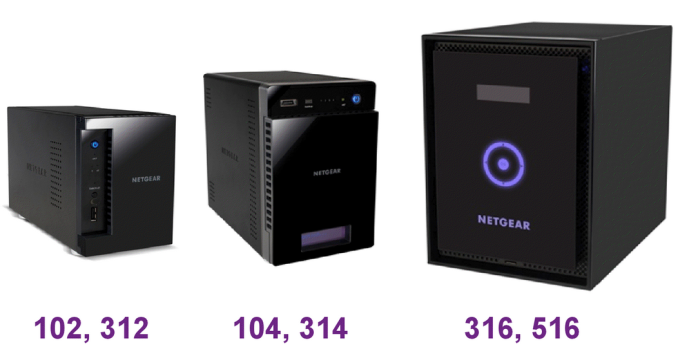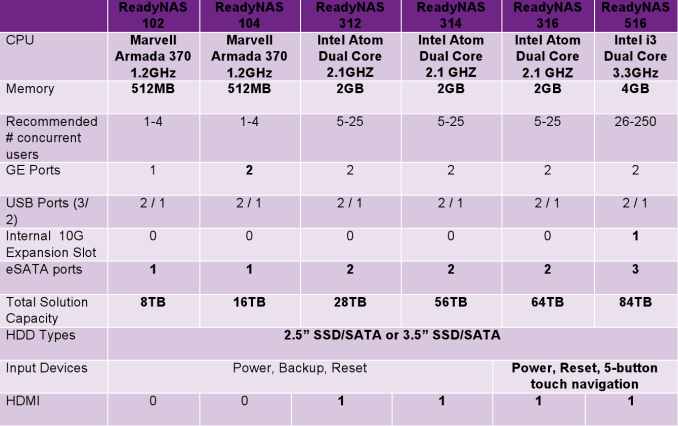ReadyNAS 100, 300 and 500 Series Reboots Netgear's SMB NAS Lineup
by Ganesh T S on March 18, 2013 8:30 AM EST- Posted in
- NAS
- Storage
- NetGear
- Enterprise

Netgear got into the SMB / SOHO / consumer NAS market with the purchase of Infrant Technologies in May 2007. The first generation ReadyNAS NV products were based on Infrant's own chips (using a SPARC core). A few years later, Netgear also started producing models based on Intel platforms. These included the Pro, Ultra and Ultra Plus models. Netgear soon realized that the market served by Infrant's old chips (low to mid-range SMB / SOHO / consumer) was being taken over by models based on Marvell's ARM based platforms. To address this, the ReadyNAS Duo v2 and ReadyNAS NV+ v2 were introduced in late 2011. The result was that Netgear had three variants of its RAIDiator OS with different features (one for the SPARC-based Infrant chips, one for x86 and one for ARM). The naming convention for each of the models was also not consumer friendly.
Today, Netgear is taking steps to correct these issues with the launch of new models as well as a completely new operating system, the ReadyNAS OS 6.
Hardware Refresh:
The Marvell-based Duo v2 and NV+ v2 are being replaced with the next-generation ARMADA 370-based ReadyNAS 102 and 104 respectively. The amount of DRAM is also doubled from 256 to 512 MB. Models in the 300 series are based on the Intel Atom D2701 platform, while the 500 series is based on the Intel Core i3-3220. The final digit in each model number refers to the number of bays available. A comparison of the different models is provided in the table below:
Some of the interesting hardware features include the addition of an IR receiver in some of the models, as well as a touchscreen in the 500 series. Netgear is also introducing Expansion Disk Array (EDA) units to provide scalability using the eSATA port in the main device.
ReadyNAS OS 6.0:
In order to maintain a consistent feature set across all models, Netgear has decided to start on a clean slate. Therefore, ReadyNAS OS 6.0 is not going to be made available for any of the earlier models (including the Duo v2 / NV+ v2). The file system has been updated to BTRFS from ext3 / ext4. The usage of BTRFS allows Netgear to provide advanced snapshotting capabilities usually present only in enterprise NAS units. We have already seen the capabilities of ReadyNAS Replicate, a $45 add-on for scheduling secure backups across different NAS units in physically different locations. With ReadyNAS OS 6.0, this feature is included for free. The operating system also includes an antivirus engine which provides real-time protection, and not just scheduled scans. Full iSCSI support for virtualized environments is available (with VMWare and Microsoft certifications).
An update to the firmware in late May is scheduled to bring in encryption support to the OS. AES-256 will be used and the key will be stored / required to be available on a USB dongle connected to the NAS. An unfortunate aspect seems to be the fact that none of the models in the 100 / 300 / 500 series have hardware accelerated encryption support.
Amongst consumer targeted features, ReadyNAS OS 6.0 supports 'cloud-based' discovery, where the user can just enter the serial number of the NAS unit to be set up online, and Netgear's backend handles the firmware initialization and first-time actions. This has been typically handled by the RAIDar utility (which will also continue to be supported). This ReadyCLOUD feature can not only be used for discovery, but also management and access. Support is also in place for local and remote backup / restore with Time Machine. DLNA is a standard feature in all NAS units now. Netgear claims that they need only a single DLNA server to service both local and remote devices. The ReadyDROP feature provides Dropbox-like real time file synchronization between mobile devices / PCs and a ReadyNAS device. Netgear's Genie Marketplace is also available on the new devices for access to free as well as paid apps which extend the functionality of the device.
Pricing and Availability:
The ReadyNAS 100 and 300 series are available for purchase today, while the 500 series will make its appearance in the market next month. Both diskless and populated models are available. MSRP for diskless configurations are provided below:
- ReadyNAS 102 : $199
- ReadyNAS 312 : $449
- ReadyNAS 516 : $1299
Netgear is also introducing the 4-bay rackmount ReadyNAS 2120 for $1229. More details regarding the internal hardware platform of this model will be made available later.












21 Comments
View All Comments
DanNeely - Monday, March 18, 2013 - link
Instead of just listing capacity, could you add the number of drive bays directly? I'm assuming the listed numbers are based on 4TB drives; but barring deliberate firmware restrictions those capacities will be out of date when the next generation of drives become available.Taristin - Monday, March 18, 2013 - link
"The final digit in each model number refers to the number of bays available."sligett - Monday, March 18, 2013 - link
It seems the final two digits refer to the number of bays available? Or does the 316 have 4 16TB drives in it?DanNeely - Monday, March 18, 2013 - link
If it is final 2 digits, there are multiple apparent typos in the table. 312 should be 48 unless it maxes out at 2.3TB drives and the 516 should be 64 unless it was rated with 5.25TB drives instead of 4GB ones.cjb110 - Tuesday, March 19, 2013 - link
In table order its 2 bay, 4 bay, 2 bay, 4 bay, 6 bay, 6 bay. I assume the 516 supports larger drives hence the capacity differences. (or the 316 is limited in some way)Aegrum - Monday, March 18, 2013 - link
"Therefore, ReadyNAS OS 6.0 is not going to be made available for any of the earlier models (including the Duo v2 / NV+ v2)"As a Duo v2 owner, this saddens me. Their support of the Duo v2 has been hilariously lackluster. They have almost no ARM support, none of the iOs apps work, and their "dropbox" like ReadyDROP requires a separate network device be installed, so you can't use it on any managed network. I wish I had gotten a Synology instead ... /pout
Kralizec - Monday, March 18, 2013 - link
Now what I really see here is Netgear abandoning its commitment to old products. When the Readynas Duo V2 was launched they promised to update the interface for the intel line to ReadyNAS os5. That was end of 2011 and has yet to happen. Now they are announcing an os6 and at least being honest in saying it won't be back ported. I used to love my netgear products but their support has gone to crap lately. Had another unit with a lifetime warrantee they failed to honor. Do not buy netgear.Integr8d - Tuesday, March 19, 2013 - link
Own a ReadyNAS Ultra 6 Plus... Performance is okay. Software is lacking. The fact that Netgear has decided to drop support on a box that's fully capable of running the latest build is ridiculous. Not to mention the promised updates that never came. Bug fixes have been few and far (and I mean far) between. So buyer beware. For $1000 just over a year ago, on a NAS with plenty of power, to get shoved aside like this is a major cause for concern for anyone considering their products. /bitterDirector12 - Tuesday, March 26, 2013 - link
I concur. I had a Netgear streaming box that stopped working when Windows 7 came out, even though the units were still being sold they never updated them to work with Windows 7 so no more NetGear for me. (Got my eye on a nice QNAP TS-419 ATM. )sunbear - Wednesday, March 27, 2013 - link
I had a readynas for many years. In the early days they had no competition and I think they under invested in developing the platform. The interface barely changed in 10 years. They also clung to the poorly performing custom fpga based designs for too long and were slow to adopt arm processors. Netgear was also slow to add esata or USB 3 to their products, instead clinging to a USB interface that meant that a full backup could run for days. Finally they rolled out USB 3 but the performance of their implementation was no better than USB 2! The only saving grace was the thriving forum where high quality help was always available. Now there's not a single netgear employee active on the forums. It looks like netgear is now attempting to compete on price and features but the competition has had hardware out that can match or exceed netgear's latest offering for at least a year already.